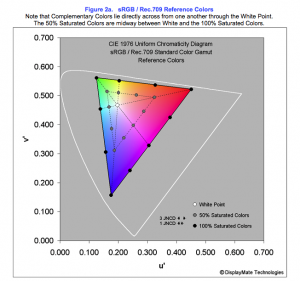Display Metrology – A new display color accuracy metric was developed by DisplayMate and used by the lab, to help identify the mobile display panel with absolute color accuracy.
 The lab made famous by its Industry Display Shoot-Outs, tested AMOLED and LCD display panels from a field of the Top Six Mobile Display Devices and identified the Best of the Best displays with the Samsung Galaxy Note 4 achieving “…first place in all categories”, wrote Dr. Ray Soneira in his review of the results on Tuesday November 18. (See our Display Daily for a full results chart and more coverage.)
The lab made famous by its Industry Display Shoot-Outs, tested AMOLED and LCD display panels from a field of the Top Six Mobile Display Devices and identified the Best of the Best displays with the Samsung Galaxy Note 4 achieving “…first place in all categories”, wrote Dr. Ray Soneira in his review of the results on Tuesday November 18. (See our Display Daily for a full results chart and more coverage.)
To get there, Soneira said he needed to develop a new independent) measurement that accurately assesses facial and skin tone colors. “While the eye is sensitive to a very wide range of colors, some colors are more important than others. In particular, it is especially important to accurately render facial skin tone colors (for people of all races worldwide). So second, we will measure and analyze the accuracy of facial skin tone colors independently”, Soneira said in his lab test result write-up.
Organic colors (found in nature) are also measured independently in the Absolute Color Accuracy shoot-out, and like facial colors, (yes, we know also organic) are heavily weighted in the red to green parts of the spectrum, according to Soneira. They are the most familiar colors to us, and heavily used in advertising (just look closely at the next car ad you see online or on TV).
This independent measurement of facial skin tone and (other) organic colors displayed, proved worth the effort as the data revealed some remarkable distinctions among the best mobile display panels. For instance, Apple’s newest iPhone 6 Plus and iPad Air 2 both scored poorly in the shoot-out with overall assessment of absolute color accuracy ranking in last place (albeit among the top six mobile devices). But Apple’s display team paid particular attention to skin tone and organic color accuracy. While still (slightly) bested by the new Samsung Galaxy Note 4 (running in the “basic mode”, one of four display modes users can set). Apple’s iPad Air 2, did score particularly high in the two measurements, with an average color error of just 0.0069 and 0.0057 (respectively) that translated to a just noticeable color difference (JNCD) of 1.7 and 1.4. Scores high enough to earn second place in skin tone and organic color accuracy categories. But the device fell far short in its accurate rendition of both blue region color and (consequently) full gamut color accuracy, the later score was the worst in the field of six, with a 0.0155 average color error and JNCD at 3.9.
Soneira said absolute color accuracy numbers were skewed by Apple’s over saturated Blue primary, “…that increases the average color error significantly”, since the blue region accounts for almost one-quarter of the entire spectrum. This problem is not limited to Apple. Soneira identified a “major stumbling block” for manufacturers created by the “…bluish color cast for all images that significantly degrades color accuracy”, he said. This is generated by the bluish white points with 7,000-8,500 K used by many manufacturers, that seem to like it for their “text screen backgrounds”, according to Soneira.
Since the days of dot matrix line printers, providing a static print out of a computer’s “results” to today’s UHD TVs, monitors and QHD mobile display panels, we have been on a continuing quest for improving our information display devices. We see the industry served well by this shoot-out exercise that continually pushes the manufacturers to improve the display, and ultimately the end user experience. – Steve Sechrist

